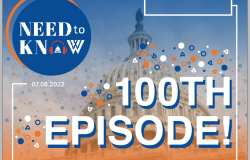The Politics and Processes of Congress
I have been asked to discuss the "politics and processes of Congress" in the context of the current 108th Congress so that you will hopefully come away with a little better understanding of what you have been witnessing in this wild and crazy town.
Back in the early 1900s a Russian named Boris Marshalov visited the United States and had a chance to sit in on a session of the House of Representatives here in Washington, D.C.
When he left the visitors' gallery, he was asked by one of his American hosts what he thought of it all. He replied, "Your Congress is very strange. A man gets up to speak; he says nothing; nobody listens; and when he sits down, everyone gets up to disagree."
In many ways, things haven't changed all that much over the last 100 years or so. What you, as foreign observers, and what most Americans see of Congress is a lot of disagreement. And that is especially true in this election year.
That disagreement arises out of both the politics and processes of our government.
I define politics simply as "the struggle for power," and, in the context of our government, as "the struggle for power in order to influence policy, and to determine how resources are allocated, that is, how Federal money should be spent."
The processes of Congress I define as. "those rules, procedures, and practices by which the majority organizes the institution to do business and to achieve its power goals of policymaking and resource allocation."
Having laid that groundwork, let me now turn to the five types of power struggles that go on every day in this town, and how they play out in the processes Congress has designed for itself. When I am finished, hopefully you will have a better understanding of why there is so much disagreement and, yet, why it is so central to the functioning of our system.
The five power struggles I will discuss are:
-First, the struggle between the President and Congress;
-Second, the struggle between the House and the Senate;
-Third, the struggle between the political parties;
-Fourth, the struggles between elected majority party leaders and majority party committee chairmen; and
-Fifth, the struggle of individual members to get the most for their districts and states from the Federal government and thereby to ensure their reelection.
First, the struggle between the President and Congress. What is most difficult for many foreign observers to understand is that ours is not a parliamentary democracy.
The President does not control Congress or dictate his policies to it. Our Constitution specifically divided powers between the three branches of government so that no single branch could dominate the others.
Even when the President and both houses of Congress are of the same political party, Congress often disagrees with the President's priorities, or at least the specifics of some of his policy recommendations. You are seeing it now in the fight over the highway bill where the President is threatening a veto because he thinks Congress is spending way too much money.
The powers are separated yet shared; the President can propose legislation; Congress can change it to its liking; and the President can veto it; and two thirds of both Houses can override that veto and thereby enact the law without the president's consent.
The President and Congress represent different constituencies. The President tends to take a more national view; Congress a more state and local view. Both are important in arriving at a mutually agreeable policy solutions that are acceptable to the greatest number of constituencies.
Second, the struggles between the House and Senate. The two houses are different in their culture, their makeup, their outlook, and their procedures. The House, has 435 members representing congressional districts of roughly 650,000 people, whereas each of the 50 states has two senators, regardless of population, who represent state interests.
House members run every two years; senators every six years. So the house tends to be more local, more parochial, more attuned to public opinion and sentiments than the Senate. It reacts more quickly to popular anger and discontent, for instance.
The House has processes that are more efficient. Less debate time on bills, fewer amendments. The Senate, on the other hand, has unlimited debate, unless 60 of the 100 members vote to close debate.
The Senate has unlimited amendments, and their amendments don't even have to be germane to the bills. Thus, we saw the welfare bill pulled from consideration in the Senate because the Democrats were trying to attach non-germane amendments to increase the minimum wage, extend unemployment compensation for workers, a block certain regulations on overtime work.
It's not unusual, therefore, for House and Senate versions of the same bill to be significantly different, and the struggle to resolve differences takes place often in prolonged and heated conference committees between the two houses.
Third, there is a constant struggle between the political parties. The majority party controls the legislative agenda. The minority party tries to obstruct or delay the majority party's bills while trying at the same time to raise its own legislative priorities.
You will hear that things are more contentious and bitter between the parties today than perhaps in 100 years, and that's mainly because neither party has a permanent grip on power. Because the majority has such razor thin margins of control in both houses, power could tip the other way in any given election. This is bound to breed tension, competition, and hostility.
So the fighting is fierce. Everyone is playing hardball -- playing for keeps, struggling for the right to wield power, never ceding an inch to the opposition.
Fourth, there is a struggle for power between elected party leaders in Congress and between the majority committee chairmen–even though they are from the same party.
Chairmen want to be able to control their committees and the legislation those committees report; party leaders have the responsibility to pass that legislation, and are becoming increasingly involved in influencing the contents of bills to make sure they pass and that the majority party gets credit and retains power. So leaders intervene more today in shaping the final contents of a bill.
Through history, power has swung back and forth between the committee system and the party leadership or caucus system. When party leaders are strong, committees are weaker, and vice versa.
Today, with every vote counting in each chamber, the party caucuses have empowered their leaders to do what is necessary to save them from politically damaging votes and to make sure that legislation important to the party passes.
Fifth, individual House and Senate members are in a constant struggle to represent their districts and states through constituent service and by "bringing home the bacon"– district and state projects– so they can get elected.
So, they are constantly struggling to get their leadership's attention and help, the help of committee chairmen, and the help of the executive branch bureaucracy.
As former House Speaker Tip O'Neill used to say: "All politics is local," and if you ask a member whether his first loyalty is to his President, his party, his house of Congress, or to his constituents, he will tell you without blinking that it is first and foremost to his constituents.
You've read and seen a lot of stories in your newspapers and on TV lately about all the pork barrel legislation in various bills – special projects to benefit individual districts and states. The national media thinks this is a scandal.
To members of Congress, though, pork is not only their bread and butter, but their ticket to reelection. And to party leaders, it is often the glue that holds larger bills together and allows them to get them passed.
The three things on process I want to point out are first: each Houses has about 20 committees to which legislation is referred and most bills brought to the floor go through the lawmaking process you see in the diagram on page 8 of your hand-out. But House committees tend to matter more than Senate committees, mainly because the Senate is more open about amending bills on the floor than House is; and second, because Senators are spread more thinly in committee assignments.
And that leads to my second point on process, which is that the House leadership has the Rules Committee to serve as its scheduling arm to determine the rules for debate and amendment, and, on major bills, the Rules Committee, acting on leadership instructions, severely restricts the amendment process in its special rule resolutions, which must be approved by a House majority.
The Senate has no comparable committee or ways to limit amendments other than by unanimous consent, to which any member can object, or by invoking cloture, which is a motion to end debate and requires a super-majority vote of 60 senators.
So the joke is, that while the House has 28 standing rules plus special rules from the Rules Committee on each major bill, the Senate has just two rules: unanimous consent and exhaustion.
The third point I want to make on process is that when the leadership is empowered by the majority caucus to take extraordinary steps to get things done, the House leadership not only has the Rules Committee, but other devices to by-pass the normal process to avoid delays or to avoid embarrassing political situations (like losing a vote). One of these is keeping a rollcall floor vote open for three hours, instead of the usual 15 minutes, to switch enough votes to win– as it did on the Medicare prescription drug bill conference report a while back.
In conclusion, you can understand the Congress and our system of government better if you view it from the perspective of these five, ongoing power struggles that are inherent either in our Constitution's design or in longstanding practice.
It often seems very dysfunctional; it often seems that these power struggles only produce gridlock, stalemate, and a lot of petty, partisan bickering.
But, at the end of the day, if Congress does not produce what the people expect of it, then the people will simply change representatives and senators, and even presidents, in the next election.
That's the final check, the most important check in our system of checks and balances on a government that abuses power–and that is the check that the people have at the polls to overthrow their government by peaceful means.
In the final analysis, public opinion, public needs, and public demands, when they reach a certain level of momentum and consensus, will get the attention of the Congress, just as a two-by-four plank of wood gets the attention of a stubborn mule.
With that, I will be happy to answer your questions.
About the Author

Donald Wolfensberger
Former Director, the Congress Project, Wilson Center; Former Staff Director, House Rules Committee










